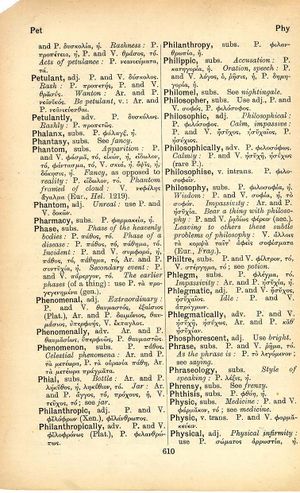phalanx: Difference between revisions
ἀγαπήσεις τὸν πλησίον σου ὡς σεαυτόν → love your neighbor as yourself, thou shalt love thy neighbour as thyself, love thy neighbour as thyself
(D_7) |
(Gf-D_7) |
||
| Line 1: | Line 1: | ||
{{Woodhouse1 | {{Woodhouse1 | ||
|Text=[[File:woodhouse_610.jpg|thumb|link= | |Text=[[File:woodhouse_610.jpg|thumb | ||
|link={{filepath:woodhouse_610.jpg}}]]'''subs.''' | |||
P. [[φάλαγξ]], ἡ. | P. [[φάλαγξ]], ἡ. | ||
}} | }} | ||
| Line 7: | Line 8: | ||
}} | }} | ||
{{Gaffiot | {{Gaffiot | ||
|gf=<b>phălanx</b>,¹¹ angis, f. ([[φάλαγξ]]),<br /><b>1</b> phalange [grecque] : Nep. Chabr. 1, 2 ; Pel. 4, 2 || phalange [macédonienne] : Nep. Eum. 7, 1 ; Curt. 3, 2, 13 ; Liv. 31, 39, 10 ; 32, 17, 11 || formation de combat des Gaulois et des Germains : Cæs. G. 1, 24, 5 ; 1, 52<br /><b>2</b> [en gén.] troupe, bataillon, armée : Virg. En. 6, 489 ; 12, 662<br /><b>3</b> [fig.] foule, grand nombre : Prud. Psych. 816. | |gf=<b>phălanx</b>,¹¹ angis, f. ([[φάλαγξ]]),<br /><b>1</b> phalange [grecque] : Nep. Chabr. 1, 2 ; Pel. 4, 2 || phalange [macédonienne] : Nep. Eum. 7, 1 ; Curt. 3, 2, 13 ; Liv. 31, 39, 10 ; 32, 17, 11 || formation de combat des Gaulois et des Germains : Cæs. G. 1, 24, 5 ; 1, 52<br /><b>2</b> [en gén.] troupe, bataillon, armée : Virg. En. 6, 489 ; 12, 662<br /><b>3</b> [fig.] foule, grand nombre : Prud. Psych. 816.||phalange [macédonienne] : Nep. Eum. 7, 1 ; Curt. 3, 2, 13 ; Liv. 31, 39, 10 ; 32, 17, 11||formation de combat des Gaulois et des Germains : Cæs. G. 1, 24, 5 ; 1, 52<br /><b>2</b> [en gén.] troupe, bataillon, armée : Virg. En. 6, 489 ; 12, 662<br /><b>3</b> [fig.] foule, grand nombre : Prud. Psych. 816. | ||
}} | }} | ||
Revision as of 07:44, 14 August 2017
English > Greek (Woodhouse)
subs.
P. φάλαγξ, ἡ.
Latin > English (Lewis & Short)
phălanx: (post-class. fălanx), angis, f., = φάλαγξ.
I In gen.
A Lit., a band of soldiers, a host drawn up in close order (poet.): Agamemnoniae phalanges, Verg. A. 6, 489: densae, id. ib. 12, 662: Tuscorum, id. ib. 12, 551: animosa (said of eight brothers fighting together), id. ib. 12, 277: junctae umbone phalanges, Juv. 2, 46.—
B Trop., a host, multitude (postclass.): culparum, Prud. Psych. 816.—
II In partic.
A Among the Athenians and Spartans, a division of an army drawn up in battle array, a battalion, phalanx, Nep. Chabr. 1, 2; id. Pelop. 4, 2.—
B The Macedonian order of battle, a Macedonian phalanx (a compact parallelogram of fifty men abreast and sixteen deep), Nep. Eum. 7, 1; Curt. 3, 2, 13; Liv. 31, 39, 10; cf.: quae (cohortes) cuneum Macedonum (phalangem ipsi vocant) perrumperent, id. 32, 17, 11: fecerat et falangem triginta milium hominum, Lampr. Alex. Sev. 50, 5.—
2 An order of battle of the Gauls and Germans, forming a parallelogram: Helvetii confertissimā acie, phalange factā, etc., Caes. B. G. 1, 24; 1, 52: phalangem perfringere, id. ib. 1, 25.
Latin > French (Gaffiot 2016)
phălanx,¹¹ angis, f. (φάλαγξ),
1 phalange [grecque] : Nep. Chabr. 1, 2 ; Pel. 4, 2 || phalange [macédonienne] : Nep. Eum. 7, 1 ; Curt. 3, 2, 13 ; Liv. 31, 39, 10 ; 32, 17, 11 || formation de combat des Gaulois et des Germains : Cæs. G. 1, 24, 5 ; 1, 52
2 [en gén.] troupe, bataillon, armée : Virg. En. 6, 489 ; 12, 662
3 [fig.] foule, grand nombre : Prud. Psych. 816.

